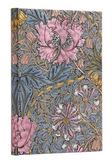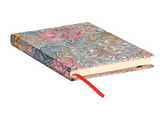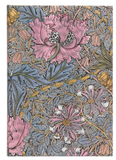William Morris Pink Honeysuckle Hardcover Journal
The design of this small, hardcover journal is based on William Morris’s celebrated honeysuckle pattern, originally printed on cotton fabric with natural dyes. The image reflects his abiding interest in naturalism.
The 176-page lined journal has a ribbon marker in a coordinating color chosen to complement the cover and has an accordion-style memento pouch.
The binding boards are 100% recycled; the pages are acid-free FSC certified paper. The binding is Smyth sewn, a traditional technique that results in a sturdy yet flexible book.
William Morris (1834–1896) is one of the most renowned figures in the decorative arts. The Arts and Crafts movement, inspired by the ideals of Morris, with his firm belief in the essential value of art and handicraft, and the social theorist John Ruskin, had as much of an anti-industrial ideological component as it did an aesthetic teaching.
Studying Classics at Oxford University, Morris developed an interest in the history, social values, and art of the Middle Ages. His appreciation of the medieval theme found its way into his designs, with patterns often replicating the “millefleurs” style of the 15th and 16th centuries. Characterized by an abundance of small decorative flowers and plants used to fill the background space, this style is most closely associated with the tapestry-making traditions of France and Belgium.
Morris was also an influential writer and staunch social activist and was aghast at the effect that industrialization was having on human productivity. New methods of production eroded the value of individual skill and a sense of accomplishment that came with the process of handiwork. He perceived medieval crafts guilds to be an ideal arrangement, where everyone contributed according to their own skill, and art and creation were a lived experience for both craftsmen and consumers. When he founded an interior design business together with a few like-minded associates, it followed the guild model and relied on traditional labor-intensive methods of production.
Ultimately, Morris believed that traditional crafts ensured higher-quality products, and so he made his furnishings using traditional weaving and the old technique of hand woodblock printing. For motifs, he looked to nature as his primary source of inspiration, which for him had an added element of defiance to the corrosive Industrial Revolution.
176 pages; lined; 3¾" W x 5½" H x ¾” D; elastic band closure.
Product SKU:



